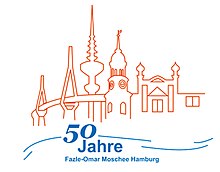Fazle Omar Mosque
| Fazle Omar Mosque | |
|---|---|

|
|
| Coordinates : 53 ° 35 ′ 1 " N , 9 ° 56 ′ 36" E | |
| place | Hamburg |
| Laying of the foundation stone | February 22, 1957 |
| opening | June 22, 1957 |
| Direction / grouping | AMJ |
| Architectural information | |
| Details | |
| Prayer room | 40 m² |
| Property | 1500 m² |
| Minarets | 2 |
| Minaret height | 8 m |
|
|
|
| Website: fazleomarmoschee.de | |
The Fazle Omar Mosque ( Urdu مسجد فضلِ عمر DMG Masǧid Faḍl ʿUmar ) was opened on June 22, 1957 in the Hamburg district of Stellingen in Wieckstrasse by the Ahmadiyya Muslim Jamaat (AMJ). After the mosque in the so-called half-moon camp in Wünsdorf near Zossen , a camp for Muslim prisoners of war during the First World War , and the Wilmersdorfer Mosque in Berlin, it is the third oldest mosque in Germany and the first mosque to be built after the Second World War .
history
The idea of building an Islamic house of prayer arose in 1955 when Mirza Bashir ud-Din Mahmud Ahmad , Khalifat ul-Massih II and head of the global AMJ, first visited Hamburg. On June 27, 1955 he was received by Josef von Fisenne (CDU), at that time senator of the building authorities and later of the police authority (interior), in the Hamburg city hall.
The foundation stone for the construction of the mosque was laid on February 22, 1957. The construction was financed by the AMJ. In addition, credit institutions such as Deutsche Bank , Dresdner Bank and Vereinsbank participated with donations of 500 DM each . The architect of the mosque was a German-born Ahmadi Muslim who had previously converted to Islam through the missionary work of Imam Chaudhry Abdul Latif. Imam Latif was the father of the meteorologist Mojib Latif .
The chairman of the International Court of Justice , Sir Muhammad Zafrullah Khan , opened the Fazle Omar Mosque on June 22, 1957. The district office manager Stellingen / Eimsbüttel and professors from the University of Hamburg as well as the ambassadors from Pakistan , India and the Netherlands were present at the opening ceremony .
The construction of the Hamburg mosque was followed by the Nuur mosque in Frankfurt am Main just two years later .
Importance of the mosque
Until the Imam Ali Mosque was completed in 1965, the Fazle Omar Mosque was the only Islamic place of prayer in Hamburg and the surrounding area. The new mosque is an important sign in the history of Islam in Germany and enabled the organizational diversification of religious life in Hamburg . The AMJ has been using the mosque for interreligious dialogues and discussion groups from the very beginning. It also takes part in the Open Mosque Day to symbolically open the door to the mosque to the citizens, although the mosque is open all year round and is used as an information point for school classes, groups of authorities and other institutions.
